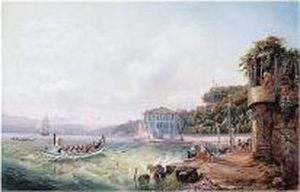August George Mayer Paintings
August George Mayer, born in 1885, was an influential figure in the realm of art and design, particularly known for his contributions to the Art Nouveau and Art Deco movements. Despite the lack of widespread recognition in the broader public discourse on art history, Mayer's work nonetheless played a significant role in the development and propagation of these styles, which emphasized ornamental and geometric forms.
Mayer's career spanned a period of rapid change in the art world, with the early 20th century seeing a departure from the rigid forms of the past to more fluid and abstract designs. His work, often characterized by elegant lines and a harmonious blend of natural and synthetic forms, captured the essence of the era's aesthetic explorations. Mayer was adept in a variety of mediums, including painting, graphic design, and decorative arts, allowing him to express his artistic vision across a broad spectrum of the visual arts.
Despite the challenges posed by the two World Wars, Mayer continued to evolve his style, incorporating elements of modernism into his work. His ability to adapt and innovate helped him remain relevant in an increasingly competitive and rapidly changing art scene. Unfortunately, Mayer's career was cut short by his untimely death in 1944, during the tumultuous times of the Second World War.
Today, August George Mayer is remembered for his contributions to the Art Nouveau and Art Deco movements, his work serving as a testament to the vibrant and dynamic spirit of early 20th-century art. Although his name may not be as familiar as some of his contemporaries, his legacy lives on through his contributions to the visual language of one of the most exciting periods in the history of art.



